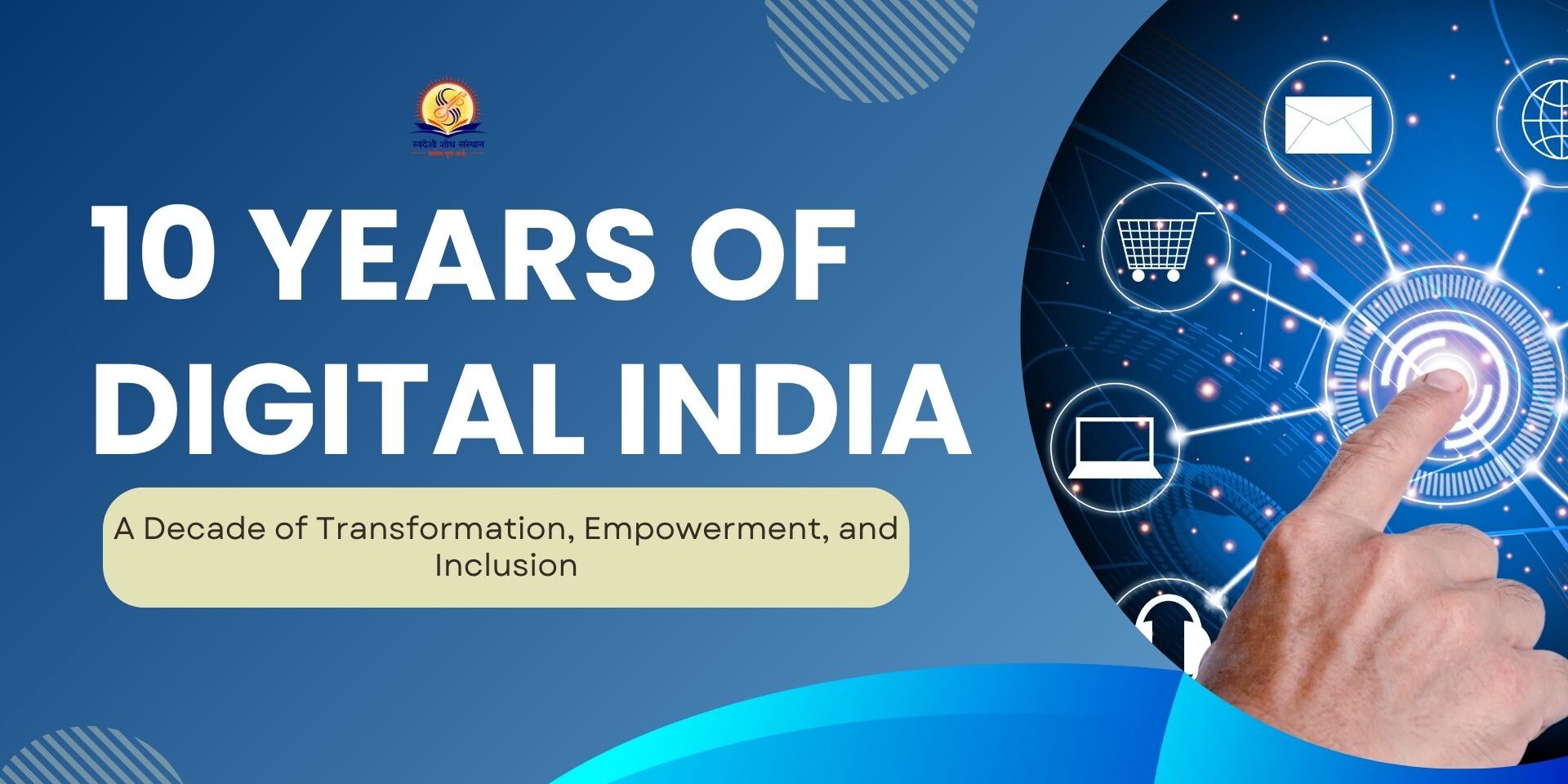10 Years of Digital India: A Decade of Transformation, Empowerment, and Inclusion
By Vaibhav Pandey
On July 1, 2015, the Government of India launched the Digital India initiative with a singular vision: to bridge the digital divide, make government services more accessible, and shape a digitally empowered society and knowledge economy (MeitY, 2015). Now, in 2025, Digital India stands as not just a milestone but a movement—reshaping the nation’s socio-economic fabric and changing the way every Indian lives, works, and connects (PMINDIA, 2025).
Digital Infrastructure: Building the Backbone of a Digital Nation
The transformative power of Digital India rests on the rapid expansion of digital infrastructure:
Internet Explosion: Internet connections in India surged from 250 million in 2014 to nearly 970 million by 2025—a staggering 285% growth (TRAI, 2024). This exponential rise has demystified the digital world for rural and urban users alike, making connectivity a way of life, not a privilege.
Affordable Data Access: Data rates fell from ₹308 per GB in 2014 to just ₹9.34 by 2022, thanks to robust competition and infrastructure investment (RBI, 2023). Mobile phones became the gateway to the digital world for 1.16 billion users, with 4G now reaching over 6 lakh villages (Digital India, 2024).
5G Revolution: In under two years, India set up 4.74 lakh 5G towers, covering 99.6% of all districts, propelling digital services in speed and reach (PIB, 2025a).
BharatNet for Rural India: To ensure no village is left behind, BharatNet connected over 2.18 lakh Gram Panchayats with 6.92 lakh km of high-speed optical fibre, bridging the urban-rural digital gap (Digital India Portal, 2025).
Digital Services: From Government at Your Doorstep to Government in Your Pocket
Convenient, inclusive, and transparent services are now a reality for millions:
Aadhaar & Direct Benefit Transfers (DBT): Over 142 crore Aadhaar cards enable secure identification. By April 2025, ₹44 lakh crore had been transferred directly to beneficiaries, eliminating middlemen and saving the exchequer nearly ₹3.5 lakh crore by cracking down on fake claims and duplicate beneficiaries (UIDAI, 2025; DBT Bharat, 2025).
Unified Payments Interface (UPI): UPI has emerged as a global case study for digital innovation. In April 2025 alone, Indians conducted 1,867.7 crore transactions worth ₹24.77 lakh crore using UPI. The platform now leads 49% of global real-time digital transactions (NPCI, 2025).
DigiLocker & UMANG: Over 53 crore Indians now store their mark sheets, licenses, and certificates securely in DigiLocker, eliminating paperwork and bureaucracy. The UMANG app aggregates 2,300+ government services in 23 Indian languages, making government accessible through a single interface (MeitY, 2025b).
Government Marketplaces: The Open Network for Digital Commerce (ONDC) and Government e-Marketplace (GeM) have revolutionized digital commerce, onboarding lakhs of sellers and bringing government procurement into a streamlined, transparent digital ecosystem (ONDC, 2025; GeM, 2025).
Digital Inclusion: Access for All, In Every Language
The heart of Digital India is inclusion—making technology truly universal:
Bhashini: This landmark language platform offers AI-enabled translation and speech-to-text in more than 35 Indian languages, ensuring every Indian can access digital resources and government services in their own tongue (Bhashini, 2025).
Skill Development: Initiatives like FutureSkills PRIME and digital skilling through Mission Karmayogi have trained lakhs of students and over 1.2 crore government officers for tomorrow’s tech jobs (NASSCOM, 2025; Mission Karmayogi, 2025).
Special Sector Solutions: Services range from telemedicine for rural patients to smart classrooms for remote students and digitized land records under SVAMITVA and AgriStack for farmers (MoRD, 2024; MoA&FW, 2024).
Real Impact, Real Stories
From its very beginning, Digital India was meant to be more than a digital strategy—it was a vision for empowerment. As PM Narendra Modi stated, “Digital India has not remained a mere government program—it has become a people’s movement” (PMINDIA, 2025).
- Villagers now stream lessons in smart classrooms via YouTube.
- Farmers check crop prices on their phones and receive subsidies directly in their bank accounts.
- Citizens everywhere store certificates digitally and make payments by scanning a QR code.
- Women and underprivileged communities join online entrepreneurship and learning, narrowing gender and social gaps.
Economic and Global Leadership
Digital India’s impact on the economy is profound:
The digital economy contributed 11.74% to national income in 2022–23, set to cross 13% by 2024–25 (Economic Survey, 2024).
India leads the world in real-time digital transactions and is increasingly seen as a trusted innovation partner in AI, semiconductors, and technology governance (NITI Aayog, 2025).
The Road Ahead
Having set the foundation, Digital India is moving from access to innovation—from connecting people to empowering them to create. With the government’s support for AI, semiconductor manufacturing, and ongoing digital skilling, India is poised to leap from a technology adopter to a global technology leader (MeitY, 2025c).
References
- Bhashini. (2025). AI Language Platform. https://www.bhashini.gov.in
- DBT Bharat. (2025). Direct Benefit Transfer Dashboard. https://dbtbharat.gov.in
- Digital India. (2024). 10 Years of Digital India – Report. Ministry of Electronics & IT.
- Digital India Portal. (2025). BharatNet Progress. https://www.digitalindia.gov.in
- Economic Survey. (2024). Economic Survey 2023–24. Ministry of Finance, Government of India.
- GeM. (2025). Government e-Marketplace Dashboard. https://gem.gov.in
- MeitY. (2015). Digital India Launch Document. Ministry of Electronics & IT.
- MeitY. (2025a). Digital Infrastructure Milestones. https://www.meity.gov.in
- MeitY. (2025b). DigiLocker and UMANG Updates. https://www.digilocker.gov.in
- MeitY. (2025c). Digital India Vision Document 2.0.
- Mission Karmayogi. (2025). Capacity Building Commission Dashboard. https://karmayogi.gov.in
- MoA&FW. (2024). AgriStack Overview. Ministry of Agriculture & Farmers’ Welfare.
- MoRD. (2024). SVAMITVA Scheme Implementation. Ministry of Rural Development.
- NASSCOM. (2025). FutureSkills PRIME Dashboard. https://futureskillsprime.in
- National Payments Corporation of India (NPCI). (2025). UPI Transaction Reports. https://www.npci.org.in
- NITI Aayog. (2025). Digital India: Global Innovation Leader.
- ONDC. (2025). Open Network for Digital Commerce Updates. https://ondc.org
- PIB. (2025a). India’s 5G Coverage Milestone. Press Information Bureau. https://pib.gov.in
- PMINDIA. (2025). A Decade of Digital India [Blog post]. https://www.pmindia.gov.in
- RBI. (2023). Data Consumption and Mobile Tariff Trends. Reserve Bank of India.
- TRAI. (2024). Telecom Subscription Report. Telecom Regulatory Authority of India. https://trai.gov.in
- UIDAI. (2025). Aadhaar Dashboard. https://uidai.gov.in



